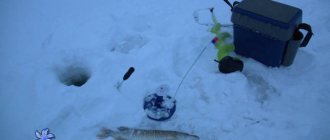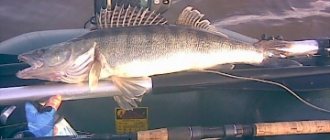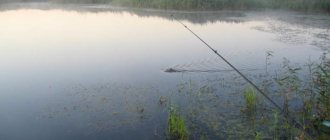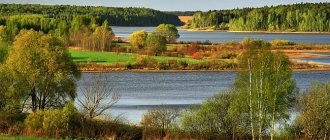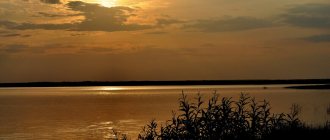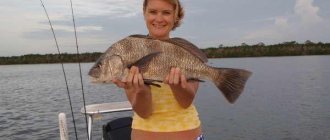Fishing on the Kama and Belaya with Alexey
I offer a brief description of fishing spots on the Nizhnekamsk reservoir, in the so-called fishing mecca (the mouth of three rivers - the Belaya River, the Ik River and the Izh River).
In addition to describing the expanses of water, I will list the species composition of fish that are most often found in fishermen’s catches. The names of the places listed below are presented as they are called by fishermen of Udmurtia. 1. Somovya Kurya
- right-hand bay of the river. Belaya, through it there is a passage to Lake Somovye, and then to Lake Bolshiye Malyashi. The far dead-end part is shallower and overgrown with aquatic vegetation. It is separated from the river bed by a ridge of islands alternating with reed thickets. Winter: mainly perch and roach, sometimes pike perch, on the girders - pike, on the river bed - bream, pike perch, bersh, burbot. Summer: you can catch all kinds of fish with a float rod (roach, bleak, bluefish, silver bream, bream, crucian carp, ide), with a spinning rod - pike, perch, asp, on the riverbed - pike perch, bersh.
2. Semistrovo
- several left-sided bays with many channels connecting the bays with each other. Winter: roach, perch, pike on the girders. Summer: float tackle - sometimes tench, spinning gear - pike, perch, sometimes catfish, on holes in channels - pike perch.
3. Sagadak
- a bay in the form of a large arc with several flooded ditches and characteristic narrow outlets, where when the level of the reservoir changes, a decent current is created, creating dangerous lanes in winter. Most of the bay is thickets of aquatic vegetation. Winter: roach, perch, pike on the girders. Summer: float tackle - pike, perch for spinning, sometimes asp, even less often - catfish, sometimes pike perch in the pits.
4. Small Sagadak
- a smaller copy of his older brother.
5. Three Rivers
- a unique place where three flooded oxbow lakes meet, outwardly not revealing themselves in any way. Decent spaces with various terrains and depths of up to 10 meters. When the water level changes, the resulting streams meet and the effect of river confluence is created. Winter: pike perch, rarely roach and perch, and pike on the girders. Summer: float tackle -, less often - crucian carp, for spinning - pike perch, pike, asp, perch, sometimes - catfish.
6. Derbeshka
- a huge bay, on the east it is decorated with a ravine with a pine forest, one of the flooded oxbow lakes runs along almost the entire perimeter, but most of it has shallow depths (2-4 m). It is separated from the Kama and the old riverbed by the White Ridge of reed islands, thanks to which there are many small overgrown bays. Counts . Winter: perch, roach, pike on the girders. Summer: on a float tackle - perch, pike on a spinning rod, sometimes on the edge of an oxbow lake - pike perch and asp. At the exit to the Kama, perch and asp pots are often set up.
7. Ust-Belsk
- a settlement where there is a maximum number of recreation centers and private fishing houses-hotels. Large boat parking area. In winter, delivery of fishermen to cool places is organized. Most of the fishing routes of fishermen of Udmurtia across the expanses of the Nizhnekamsk fishing mecca begin from here. Fishing spots begin directly near the village. The channel and right-hand bays are the prerogative of coastal fishermen or rowing fleet owners. In the area where the Belaya flows into the Kama there are many different places for fishing, both in the riverbed areas and in the adjacent bays. Winter: pike perch, bream, bream, burbot, perch, roach, pike in the bays of the girders. Summer: for float and bottom tackle - occasionally - sabrefish, lately often - sculpin goby. For spinning - pike perch, bersh, asp, perch, pike. Catfish are actively caught using quok and bottom gear.
8. Telegovsky Island
It is interesting in that it divides the Kama into two approximately equal streams, but with different reliefs: the right one, navigable, more even, but at the same time deep, the left one is characterized by various sand spits and various edges, which were formed from the activity of dredgers. The island itself has many side adjacent and internal bays, where there is no current at all. Winter: pike perch, bersh, bream, roach occasionally - ide, burbot, in the bays of the girders - pike. Summer: for float and bottom tackle - for spinning - pike perch, bersh, asp, perch, pike, rarely - chub and ide. Catfish are actively caught using quok and bottom gear.
9. Zuev's Keys
— numerous right-sided Kama bays. Walking distance has made them a favorite destination for winter fishermen. In summer, this is a pike perch Eldorado with clearer water than in the reservoir itself. And many underwater springs maintain an increased oxygen composition of the water. The channel part of the Kama is characterized by differences in depth; there are depths of up to 20 meters. Winter: in the bays - perch, roach, on the girders - pike, in the riverbed - pike perch, bersh, bream, roach, bluegill, silver bream, sometimes burbot. Summer: for float tackle - crucian carp, for spinning in the bays - perch, pike, on the riverbed - pike perch, bersh, asp, the same perch and pike, rarely - chub and ide. Catfish are actively caught using quok and bottom gear.
STRONG ICE OF THE KAMA SPACE
In the absence of strong ice in St. Petersburg, some fishermen continued to close the open water season. Others went to neighboring regions, where winter is already in full swing. At a time when the leading sports fishermen of St. Petersburg left to get “gold” in the neighboring Vologda region at winter lure fishing competitions (by the way, very successfully), I also decided to try my luck in catching a predator at the confluence of two great Russian rivers - the Volga and Kama. The places here are known as a fishing haven both in summer and winter.
Places such as Kamskoe Ustye, Atabaevo, Sakony are popular with local fishermen for good reason. It is in these places that the old bed of the Kama and Volga, beautifully winding, comes as close as possible to the shore. After the formation of the Kuibyshev reservoir, the water surface of the mouth of the Kama and Mesha rivers and the confluence of the Kama and Volga turned into a kind of sea with a width of up to 40 km and depths of up to 20-27 meters
In summer, bream and carp and many species of predatory fish are successfully caught here. In winter, the majority of fishermen switch to fishing for pike perch and bass, some practice catching fairly large perch
I will not go into details of local gear. I’ll just say about some of the features of fishing in the middle of winter in this water area. Since after fishing on the first ice there are still legends about caught pike perch weighing 8 kg, some local fishermen try their luck with quite sports gear with rattlins, large balancers and spoons, using echo sounders and video cameras. And periodically we hear rumors about pike perch reaching 1-2 kg and successful fishing. The majority of fishermen fish with the same type of fishing rods with nods
with replanting sprat on a spoon or jig. Tulka, of course, deserves special mention, because... I haven’t seen such a stir around bait for a long time. It is considered lucky to buy sprat that is fresh, shiny and smells delicious, and not defrosted, “rusty” and smelly. Therefore, in the city, everyone knows the places where good sprat is sold (and it spoils very quickly) by heart.
I, too, succumbed to temptation and, planning to fish with rattlins, balancers and spoons, I still placed a fishing rod with a sprat next to it on a bersha
Therefore, I will not dwell on this, but will write how local fish were caught using gear using TM SPRUT products.
While getting ready for the trip, shortly before departure I learned that TM SPRUT together with the wonderful fishing website S-FISHING.PRO announced a competition of fishing reports using gear from SPRUT. And they even provided the lucky ones with some new samples for testing. I was one of the happy owners of new samples of SPRUT products for winter fishing. I spent a long time choosing, I was afraid of not guessing first of all with the size of the fish and, accordingly, the size of the bait. In the end, I chose the golden mean: rattlin SPRUT GURAME 55S 10.5g color SB2
balancer SPRUT HIKO 70 LM-UV 18g (light accumulative)
and chose SPRUT SkyLine Gold Ice tech Pro line 0.285mm, 50m, golden fluor
I would like to say a lot of flattering words about the fishing line. TM SPRUT was invisibly present on every fishing trip, no matter what I was fishing with, precisely thanks to the SkyLine fishing line, kindly provided by the organizers of the “Strong Ice” winter story competition. It looks like the line is really quite invisible to the fish, because... Angry bites from the bersh followed only the bait sank to the bottom. At the same time, the dark-golden fishing line is clearly visible on the snow-white snow. The strength of the fishing line could not be tested against large fish, but in conditions of frost, wind and sharp ice, the fishing line showed its best side: not a single tangle, not a single cut. With the SPRUT SkyLine line I used a handmade spinner bait with a reel. I wound the entire skein (50m) onto the reel. During four active fishing trips, I experienced only positive impressions. The line holds the knot well and is very wear-resistant. The fishing line was 0.28mm for larger pike perch (the line is stated to weigh up to 8 kg) and for the use of heavy balancers and rattlins. But thanks to the lack of stretchability, the line conveyed well the vibrations of the ten-gram SPRUT GURAME rattlin and the bite of medium-sized bershas. Since I did not have much experience in winter fishing, I think the fishing line forgave me for rough handling. And throwing a fishing rod onto the prickly ice and dragging from hole to hole. The SkyLine fishing line from SPRUT withstood everything. And it brought joy from the feeling of a bite.
There is still a long winter ahead and I think more than once SPRUT products will bring me good luck in winter fishing. And in the next report I will write which of the two SPRUT baits received for the test “shot” on Kama fishing. Good luck to everyone with TM SPRUT products, no tail, no scales!
Fishing on the Kama
The Kama, a left tributary of the Volga, is one of the largest rivers in Russia. Since ancient times, these places have been famous throughout the country for fishing. The Kama is home to many valuable species of fish. Here you can find fish such as rainbow trout, as well as ruff, bream and carp.
In a river as long as the Kama there is room for many species of fish. In addition, the Kama is distinguished by a changeable bottom topography: great depths alternate with shoals, reaches with numerous riffles. All this is the reason for the extreme diversity of the river’s fish population. The Kama is home to sterlet, sturgeon, bream, carp, asp, silver bream and many, many others. In the upper reaches, even such valuable fish as taimen, grayling and rainbow trout enter the river. And you can be sure that anywhere in the river a ruff will be caught on the bait.
From spring to reservoir
The Kama flows through the European part of Russia. Its source is in Udmurtia, in the village of Kuliga. Here, at an altitude of 330 m above sea level, springs flow that give rise to this great river.
From its source, the Kama flows to the northwest and northeast, but after a couple of hundred kilometers it sharply turns south and carries its waters across the Perm Territory all the way to the Kuibyshev Reservoir. In the upper reaches of the Kama it is rather inconspicuous. Looking at the narrow stream meandering through the valley, you would never say that this is one of the largest rivers in Europe. The Kama becomes full-flowing only when it turns south, after the Pilva River flows into it, and becomes a real giant below the mouth of the Vishera. Here the appearance of the banks changes dramatically: the left one becomes elevated and steep, while the right one remains low-lying.
In the middle and lower reaches of the Kama, it is regulated by a series of large reservoirs that feed three large hydroelectric power stations. The width of the channel here reaches several tens of kilometers. The construction of dams has made the nature of the river much calmer: previously its flow was 1.5 times faster.
Nature and history
Kama gives a great variety of opportunities for tourism and just a good rest. Along its long riverbed there are places to suit every taste. Fans of active recreation will be most interested in the upper reaches of the river. Far from large cities, you can find corners of untouched wilderness and feel the true spirit of adventure. In addition, it is this part of the Kama that is most interesting for kayaking due to the abundance of rapids and riffles, as well as the fast current.
Those who prefer comfort can go on a river cruise on a boat. There are many tourist routes along the Kama. Motor ships depart from Moscow, Samara, Kazan and many other cities.
The banks of the Kama River are rich in attractions, both natural and cultural. The first include, for example, the Kungur Ice Caves. They are known for their unique microclimate: the temperature inside is around 0°C. The caves stretch for 5.6 km and contain about 70 lakes, 48 grottoes and almost 150 organ pipes. Traveling along the Kama is not only the beauty of the Ural nature, but also the opportunity to visit many historically significant places. Many significant events took place on the banks of this great river - it can be said to be inextricably linked with Russian history. The ancient cities standing on the river will delight the eye with architectural monuments.
On ice and rapids
Fishing on the Kama will bring pleasure and a good catch at any time of the year. In summer, experts prefer to fish on the rifts. The latter come to life already in May, when the water level in the river levels out. Mainly perch and chub are caught here, but due to the abundance of fry, both catfish and pike often come to such places. Fishing on riffles is good because the bait suddenly appears in the fish’s field of vision. The predator grabs it without delay, because the prey escapes very quickly in a strong current. That is why the bite on the rifts is better than in quiet places where the fish have time to think: whether to grab the bait or not. Fishing on the Kama in winter is no less active. The harsh weather conditions of the Urals are the key to a durable ice cover that can be accessed by any vehicle. The main object of winter fishing is pike perch, which is traditionally caught with a spoon. You will have to go to the middle of the river to find this fish: it is found in coastal areas, but does not live there permanently. In some places, burbot is also caught along with pike perch, but only at night, so in order to profit from this fish, you will have to set up a tent on the ice.
Kama Estuary - Rocky Shelter
How long have you been hiding from the city noise among the majestic but silent stones? But they, unlike the “urban concrete jungle,” give spirituality of mind and peace of body. I think it's worth a try.
Excellent Camping Spot
Traveling through the gorges, you will be happy to find a place for a quiet and cozy vacation. Such a vacation is especially relevant in the conditions of modern life - fast-paced and almost devoid of privacy.
Sunny Beach
The Kama estuary is located on the right bank of the Volga opposite the confluence of the Kama. The location along the river invites you to soak up the sun. The main thing is to take with you a cream with a UV filter and a spray that repels insects.
Fishing Paradise
It is likely that in addition to notes of spirituality, you will want to eat. Yes, that’s right - to strengthen your strength. Well, the Kama estuary is quite suitable for fishing. No wonder it was nicknamed “a cool place” and a “fishing” paradise.
A bit of Extreme
Having refreshed yourself, feel free to put on old warm clothes and non-slip shoes, attach a flashlight to your head and go ahead to explore the famous natural monument - Yuryevskaya Cave!
The cave is known for its bizarre structure: when moving from “room” to “room”, be prepared not only for a change of scenery, but also for a change in altitude along steep paths. In addition, the cave is characterized by the presence of gypsum wells and remains. This is due to the peculiarities of gypsum dissolution.
In general, the views of the halls are amazing!!!
It is worth noting that Yuryevskaya Cave is not the only natural cave on the banks of the Volga, which means traveling through them can take more than one day. For a complete overview, I advise you to visit the Museum of History of the Kama-Ustinsky District.
Beware, red book
A special species of bat lives in the Kama estuary - the mustachioed bat. Its weight is only 5-9 grams, and it is covered with thick yellowish-sandy fur.
There will be nothing surprising in meeting an ermine. Although its population has decreased greatly today.
If we talk about flora, it is rich in relict centuries-old oaks, pines and spruces, and in total the Kama estuary is inhabited by more than 500 different species of flora.
Secured territory
The Kama estuary is not suitable for mass recreation. And when planning a vacation, you should choose a route in advance: you can get to the place by water, by bus or by car. Although... Don’t occupy yourself with what you can occupy others with - entrust the preparation of your route to us, Trip Guru.
